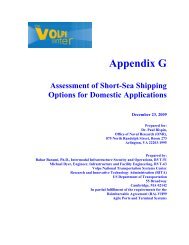R-429-G, Rev. 2 - Towmasters: the Master of Towing Vessels Assoc ...
R-429-G, Rev. 2 - Towmasters: the Master of Towing Vessels Assoc ...
R-429-G, Rev. 2 - Towmasters: the Master of Towing Vessels Assoc ...
You also want an ePaper? Increase the reach of your titles
YUMPU automatically turns print PDFs into web optimized ePapers that Google loves.
appears on our website.Congress requested <strong>the</strong> Department <strong>of</strong> HomelandSecuritys Office <strong>of</strong> <strong>the</strong> Inspector General to investigate <strong>the</strong>Coast Guards Marine Casualty Investigation Program andsubmit a report in <strong>the</strong> summer <strong>of</strong> 2007.We also believe that true adherence to <strong>the</strong> existing workhourstatutes and regulations would have led to greatermariner satisfaction and retention by giving mariners greatercontrol over <strong>the</strong>ir working conditions. Mariner retention is aserious national and international problem.We believe that <strong>the</strong> success <strong>of</strong> establishing meaningfullogbook standards is important to protecting all "lowerlevel"mariners.CONGRESS EXPRESSES CONCERN OVER“HOURS OF SERVICE”Section 409 <strong>of</strong> <strong>the</strong> Coast Guard Authorization Act <strong>of</strong>2004 (P.L. 108-293) amended 46 U.S. Code §8904 byadding one paragraph, (c), as follows:Crew Endurance ManagementDemonstration Project(c) The Secretary may prescribe by regulation requirementsfor maximum hours <strong>of</strong> service (including recording andrecordkeeping <strong>of</strong> that service) <strong>of</strong> individuals engaged on atowing vessel that is at least 26 feet in length measured fromend to end over <strong>the</strong> deck (excluding <strong>the</strong> sheer).Congress also ordered a Demonstration Project <strong>of</strong>Crew Endurance Management Systems (CEMS) beconducted before prescribing any new regulations. TheDepartment <strong>of</strong> Homeland Security delivered <strong>the</strong> Report onDemonstration Project : Implementing <strong>the</strong> Crew EnduranceManagement System (CEMS) on <strong>Towing</strong> <strong>Vessels</strong> toCongress on March 29, 2006.Congress Explained What it ExpectedCongress also provided <strong>the</strong> following wording in a JointExplanatory Statement <strong>of</strong> <strong>the</strong> Committee <strong>of</strong> Conferenceregarding Section 409:Section 409 <strong>of</strong> <strong>the</strong> House bill grants <strong>the</strong> Secretary <strong>of</strong> <strong>the</strong>Department in which <strong>the</strong> Coast Guard is operating <strong>the</strong>authority to prescribe maximum hours <strong>of</strong> service forindividuals engaged on a towing vessel that is required tohave a licensed operator under section 8904 <strong>of</strong> title 46United States Code. However, before prescribing <strong>the</strong>seregulations, <strong>the</strong> Secretary is required to conduct and reportto Congress on <strong>the</strong> results <strong>of</strong> a demonstration projectinvolving <strong>the</strong> implementation <strong>of</strong> Crew EnduranceManagement Systems on <strong>the</strong>se vessels.The Senate amendment does not contain a comparableprovision.The Conference substitute adopts <strong>the</strong> House provision.In September 2001, a towing vessel struck a bridge atSouth Padre Island, TX. The bridge collapsed, and 5 peopledied when <strong>the</strong>ir cars and trucks went into <strong>the</strong> water. On May26, 2002, a towing vessel struck <strong>the</strong> I-40 highway bridgeover <strong>the</strong> Arkansas River at Webbers Falls, OK. The bridgecollapsed, and 14 people died when <strong>the</strong>ir cars and truckswent into <strong>the</strong> Arkansas River.As a result <strong>of</strong> <strong>the</strong>se accidents, <strong>the</strong> Coast Guard and <strong>the</strong>American Waterways Operators established a joint workinggroup to examine <strong>the</strong> statistics <strong>of</strong> bridge allisions andmeasures that could be taken to help prevent <strong>the</strong>se types <strong>of</strong>casualties. The study used a database <strong>of</strong> 2,692 bridgeallision cases between 1992 and 2001. One <strong>of</strong> <strong>the</strong>recommendations <strong>of</strong> <strong>the</strong> working groups May 2003 report isto require <strong>the</strong> implementation <strong>of</strong> Crew EnduranceManagement Systems (CEMS) throughout <strong>the</strong> towingindustry as a means <strong>of</strong> improving decision making fitness.In addition, on June 1, 1999, <strong>the</strong> National TransportationSafety Board issued Recommendation M-99-1 to <strong>the</strong> CoastGuard that stated that <strong>the</strong> Coast Guard should Establishwithin 2 years scientifically-based hours-<strong>of</strong>-serviceregulations that set limits on hours <strong>of</strong> service, providepredictable work and rest schedules, and consider circadianrhythms and human sleep and rest requirements. Thissection would give <strong>the</strong> Coast Guard legal authority toimplement <strong>the</strong>se recommendations.The (Senate and House) Conferees expect that <strong>the</strong>Secretary will carefully evaluate <strong>the</strong> results <strong>of</strong> <strong>the</strong>demonstration project prior to determining <strong>the</strong> need toestablish maximum hours <strong>of</strong> service regulations as permittedunder subsection (a). Prior to promulgating any suchregulations, <strong>the</strong> Conferees also expect that <strong>the</strong> Secretary willevaluate <strong>the</strong> costs and benefits <strong>of</strong> establishing hours <strong>of</strong>service requirements on towing vessels. This evaluationshould include a review <strong>of</strong> Coast Guard casualty data todetermine whe<strong>the</strong>r <strong>the</strong>re is statistical evidence to support <strong>the</strong>need for new hours <strong>of</strong> service regulations.GCMA Position on CEMSGCMA followed <strong>the</strong> progress <strong>of</strong> <strong>the</strong> Crew EnduranceManagement Systems (CEMS) project and supports <strong>the</strong>scientific findings <strong>of</strong> <strong>the</strong> Coast Guard study. Training using<strong>the</strong> scientific findings will provide benefits to mariners whomay be expected to perform additional duties if ano<strong>the</strong>rmember <strong>of</strong> <strong>the</strong> crew is incapacitated for any reason.However, we do not support CEMS as a substitute for fulland safe manning <strong>of</strong> any vessel or for purposely sailingshort in any case o<strong>the</strong>r than a bona fide emergency.GCMA seeks to have <strong>the</strong> safety and health aspects <strong>of</strong> <strong>the</strong>existing two-watch system on all vessels manned bylower-level mariners re-evaluated in terms <strong>of</strong> <strong>the</strong> scientificfindings reported in <strong>the</strong> Coast Guards DemonstrationProject and o<strong>the</strong>r applicable literature provided to GCMA byMr. James Magill (G-MSO) during an earlier study by <strong>the</strong>National Offshore Safety Advisory Committee. (1) [ (1) .Referto GCMA File A-772.][GCMA Comment: At <strong>the</strong> time <strong>of</strong> this writing, Congressis still evaluating <strong>the</strong> results <strong>of</strong> <strong>the</strong> CEMS report.]GCMA’S LEGISLATIVE PROPOSAL[This proposal is based upon <strong>the</strong> AWO model cited above]Amend 46 U. S. Code. §11301 by adding new paragraphs"c" and "d": wording:C. GENERAL GUIDANCE/OVERVIEW5 February 2007
















